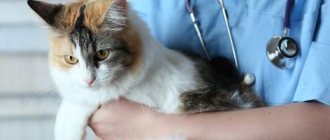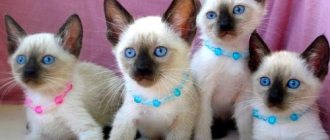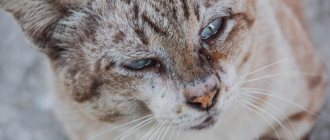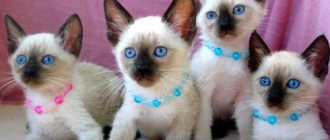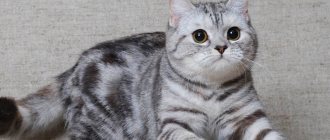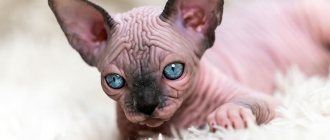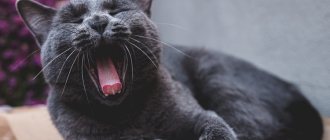Today there is a fairly widespread stereotype that a cat is considered old, having barely celebrated its 7th birthday. In this article, the Murkoshi team will not only dispel such a myth, but also share tips that will help make the life of an adult cat comfortable and happy.
1) Which cat can be considered old?
2) External and internal changes with age
3) Necessary care for an elderly pet
4) Reasons to get an older cat
Which cat can be considered old?
It is generally accepted that the age ratio of a cat to a human is approximately 1:7. Therefore, in order to accurately understand how old an animal is by human standards, owners simply multiply the cat’s age by 7. However, in the first months of life, the kitten develops very quickly. Therefore, the maturation of a cat is not proportional to the duration of maturation of a person.
Below is the approximate ratio of human and cat ages:
| Cat age: | Person's age: |
| 1 year | 18 years |
| 4 years | 25 years old |
| 7 years | 31 year |
| 10 years | 42 years |
| 15 years | 62 years old |
| 20 years | 81 years old |
As you can see, the stereotype that at 7 years old a cat is already old, and at 12 it’s time for her to die, is fundamentally incorrect. For many people, life is just beginning at 40!
The average lifespan of cats varies between 15 and 20 years. It is this period of life that is considered to be old age. However, there are many examples of how, with proper care and a healthy diet, cats live up to 22-25 years.
More about age: What do you need to know about the age of a cat?
It doesn’t matter for what reason the owner may be mistaken about the cat’s age. In any case, this can have a very bad effect on the pet's health. After all, if a person is sure that an eight-year-old cat is an old man, then he will not be very surprised and react to changes in behavior. For example, if a cat stops eating normally, begins to lose weight, sleeps a lot and does not respond to games, the owner may attribute all this to old age, thereby ignoring the symptoms of any disease. At this age, this is precisely explained by one or another disease, and if you show your pet to a veterinarian in time and treat it, then he can please you for a very, very long time.
Therefore, when taking responsibility for a pet, it is necessary to study in advance questions about its changes with age.
Only a balanced diet
A properly formulated and balanced diet will prolong the life of your pet. Older cats have decreased activity levels, making them less mobile. This changes taste preferences and preferences.
The diet of an older cat should be less high in calories, but balanced in protein, fat and carbohydrates. In this diet, the fat content is minimal, and the amount of protein does not decrease. For a natural-fed cat, vitamin-mineral complexes are added to the diet. These can be beta-carotene, vitamins B, C, E and glucosamine.
External and internal changes
From about 12-15 (and especially older) years, the following changes are likely:
- the coat turns gray and becomes thinner;
- teeth begin to loosen and even fall out;
- character becomes humble and calm;
— the animal’s mobility decreases.
In addition to external changes, changes in the functioning of internal organs may begin:
- vision, hearing and smell lose their sharpness (as a result of which the animal’s protective instincts are dulled);
— arthritis begins to bother you (limbs hurt, may swell and bend poorly);
— digestion slows down (this happens because the organs cease to secrete the required amount of elements for digestion and assimilation of food);
- tumors (often occur in the reproductive system of cats that have not been spayed or neutered);
- urinary incontinence (an old cat may simply not be able to hold it in due to a weakened sphincter).
IMPORTANT: These problems are possible, but far from necessary (this is especially true for arthritis, tumors and incontinence). Even cats at a very old age (up to 20+ years) do not always have a bunch of diseases, especially if the whiskers are well cared for.
But even if the above changes have occurred, this is not a reason to despair. They, of course, can cause some trouble for you and your cat. However, by taking the necessary measures and regularly consulting with a veterinarian, you can ensure your pet has a happy and comfortable old age!
Basic Rules
Experienced owners know that there are external signs of aging in cats , such as graying and fading of the irises of the eyes. If the behavior of an older cat is carefully observed, deterioration in hearing, vision, increased sleep duration and many other changes are noted. It is worth noting that in healthy animals these changes occur slowly and almost imperceptibly.
Even if your pet looks young and vigorous, you should adhere to the general rules. There will be some kind of problem in any case, and the sooner you find it, the better. The basic rules are as follows:
- Take your pet to the vet at least once every six months, even if he looks healthy.
- Even if your cat used to walk outside, stop letting it out . Firstly, self-walking is very dangerous, and secondly, older cats do not tolerate temperature changes well and are more prone to overheating and hypothermia.
- Make sure that your older cat does not lie on cold floors or other surfaces.
- Older cats sleep longer and need rest, so move your pet's bed to a place where it is inaccessible to children, other animals, guests, etc.
- If you notice that your cat is having difficulty walking or standing up, try to pick her up very gently. Inflammatory processes in the joints cause pain even with minor activity.
- Many older cats suffer from urinary incontinence , so take the time and effort to provide each room with a low-sided litter box.
- If you decide to bathe your cat, dry it with a hairdryer or wipe it dry.
Many owners move all the cat's accessories into one room, and this makes sense . When a cat has joint pain, it is much easier for her to eat, drink, rest and go to the toilet within the same room. When remodeling a room, keep in mind that it may be painful for your pet to jump, so either place everything on the floor or make sure that your pet can jump to the right place in several stages, for example, from a chair.
Advice: there is a tradition when one animal grows old and takes another, younger one into the house. It makes sense that when the older pet leaves, you will be left with a four-legged friend. However, you should not wait until your older cat is 9–10 years old; act sooner or refrain from getting a second pet so as not to cause additional stress to the older cat.
Always remember that your pet needs to rest between exercises, but this does not mean that the cat should not receive them. Encourage your cat's desire to play and try to pay enough attention to its activity. Be prepared for your cat to become irritable, especially after big changes (rearranging furniture, moving). If you have to travel or move, think in advance about how to make this event less traumatic for your ward. Stress is very dangerous for older cats.
Necessary care for an elderly pet
An old cat requires more careful care than a young animal. “Murkosha” advises periodically seeing a veterinarian and doing this at least once every six months. It is best to find a regular therapist who will be familiar with the medical history and all the characteristics of your cat.
Read about interaction with a veterinarian: 5 rules for effective interaction with a veterinarian
When caring for an elderly pet, you need to consider the following aspects:
1) Power
Old cats need to eat well to maintain vital energy. However, they often refuse to eat due to physical weakness, lethargy, or illness. Therefore, owners need to purchase special food. What should it be like?
— high quality and specialized for old pets;
- contain a large amount of nutrients (this food is high-calorie, so a small amount is enough for the cat to get enough of it);
- soft (older cats may have loose teeth, so regular dry food is difficult for them to bite and chew).
In addition to good food, owners should provide the cat with constant access to clean drinking water and not force it to feed. Under no circumstances should you feed an older cat from the table. This can cause her to become seriously ill, dehydrated, and have allergies.
Read more: The best food for a cat is from the table? (myths and reality)
2) Medicine and care
Do not forget about caring for the animal’s fur and claws, because in old age they grow at an accelerated pace. You also need to systematically give vitamins and do the necessary vaccinations, which are mandatory to maintain the immunity of an old cat. Otherwise, he will often be susceptible to many diseases and viruses.
3) Comfortable conditions
An animal in old age is sedentary and loves peace. Therefore, the owner must arrange a cozy place for the cat, away from drafts, so that he does not get sick. If the old man has a warm, soft and safe bed, this will also reduce the level of stress to which older cats are often susceptible.
In addition, you should consider moving your pet around the apartment: if the cat likes to climb onto window sills and cabinets, then you can place chairs near these places so that the descent is safe and there is no risk of damage to fragile joints.
Veterinary service
With the onset of old age, internal organs wear out, immunity decreases, and chronic diseases worsen. Even wounds and scrapes heal slowly because cells cannot divide as quickly as before. In older animals, cancer is diagnosed ten times more often than in young animals. Therefore, after 8-10 years, an annual medical examination for your pet would be a reasonable measure.
Even if there are no external signs of illness, a survey ultrasound and blood tests will help to detect kidney failure and other serious diseases in a timely manner.
It’s good to find a permanent veterinarian, because the older the cat gets, the more often you have to go to the clinic for various issues. It should be remembered that visiting the clinic in itself is stressful for the animal. If possible, you should make an appointment in advance to avoid long queues.
Source
Keeping your pet active
The more active the cat’s lifestyle, the better the metabolism works. In addition, active cats do not have problems with joint disease. Encourage your pet to play outdoor games, use her favorite treats and interesting toys for this. Call the cat to you more often and try to entice it if it refuses outdoor games.
Providing adequate care, monitoring the pet’s condition and its balanced diet will help maintain health and increase its life expectancy. Playing together, close communication and emotional comfort will make your pet’s life safer and help prolong it as much as possible.
- Author: Elena Romanenko
Rate this article:
- 5
- 4
- 3
- 2
- 1
(9 votes, average: 5 out of 5)
Share with your friends!
When should you go to the doctor?
A veterinarian can calculate the frequency of visits to the veterinary clinic for a cat according to its age and health, although every owner should be more attentive to their pet and know when something is wrong with it. Below is a list of the main symptoms, if you notice them, you should urgently contact a veterinarian:
– poor appetite; - weight loss; – excessive thirst; – stiffness of movements, failures or difficulties when jumping; – too much sleep; – lumps or bulges in any part of the body; – problems with balance; – constipation, difficulty urinating or attempts to shit in “wrong” places; – malaise, bad mood and disorientation; – unusual behavior – aggression, attempts to hide, constant screaming.
Taking care of your psychological state
With age, the pet weakens, becomes vulnerable and begins to feel defenseless. During this period, the owner should learn to recognize the stressful state of the pet and be able to distract it. Play with the cat and its favorite toy, or better yet, buy new ones so that your pet’s interest is shown every time.
Make time for close communication with your cat, during which you will be alone. Stroke your pet, scratch its chin or behind its ear, accompanying these actions with conversations. At this moment, not only will the cat’s psychological state improve, but the owner himself will become calmer. Don't chase away your pet if it jumped on your bed while you were sleeping. All an animal wants is to be close to someone it trusts.


